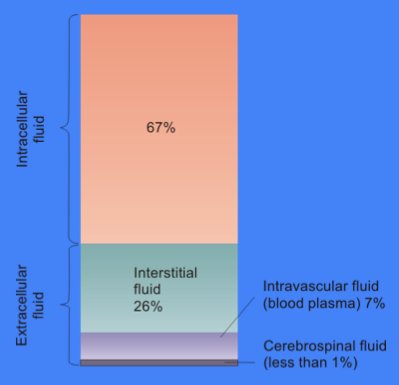Body fluids
Body fluids
Body maintenance a balance between the amount of fluid taken in and amount excreted. health promotion required maintenance of body fluids acid base balance.the proper amount of fluid needed to support these changes and to transport building and waste materials. Approximately 60% of body weight in males constitutes total body fluid, with 52% in female - it makes up 75% of brain , 70 - 75% of muscles and 22% of bones. Infants are 70 to 80% and elders are 50% water.
Water plays several important functions in body,
. Regulates body temperature.
. protect the vital organs.
. Helps to carry nutrients and oxygen to all the cells in the body.
. Cushions the joints.
. Improve intestinal health and prevent constipation.
. remove the waste product out of the body.
Fluid balance
Fluid balance is the balance between water coming into the body , from drinks and food, and water leaving the body, mainly in the urine or by dialysis. Fluid balance is the maintaining correct amount of fluid fluid in the body.Fluid compartments
1. Intracellular fluid (ICF)
It refers to the fluids are located inside the cells. The cell membranes and cellular metabolism constituents of this ICF. It contains large amount of potassium , magnesium and phosphate ions. Intracellular fluid is the body fluid compartment.
2 . Extracellular fluid (ECF)
Extracellular fluid refers to fluid outside the cells. It contains large amount of sodium, chloride and bicarbonate ions, plus substances needed for cellular function such as oxygen, glucose, fatty acids and amino acids, it also contains carbon dioxide video that is transported from the cells to the lungs to be excreted .
ECF can further divided into three types: -
Interstitial fluid, intravascular fluid or transcellular fluid.Interstitial fluid is the water that surrounds the body cells and include lymph.
Regulation of fluid balance
Hypervolemia⬇
excess fluid volume
⬇
inhibits A D H and aldosterone production
⬇
Increased urination , aur trust
⬇
Normal fluid volume restored
Hypovolemia
⬇
Decreased fluid volume
⬇
stimulate ADH and aldosterone production
⬇
decreased urination and thirst
⬇
Normal fluid volume restored
Movements of body fluids
There are four types process that are followed
- osmosis
it is the movement of substance from lower to higher.
Types of solution there are two types of solutions are present
- Isotonic solution which have same osmolarity as body fluid for example normal saline and 0.9 % naCl
- Hypertonic solution have higher osmolarity then body fluid that is percent of sodium chloride
- Hypotonic solution have low osmolarity then body fluid for example 0.45% sodium chloride
2.diffusion
it is the movement of substance from higher to lower.



Comments
Post a Comment